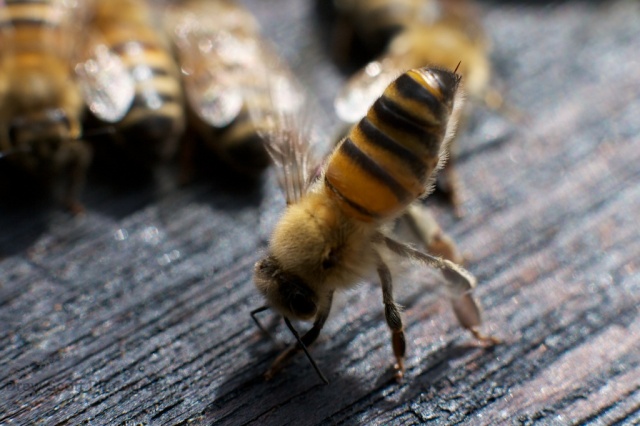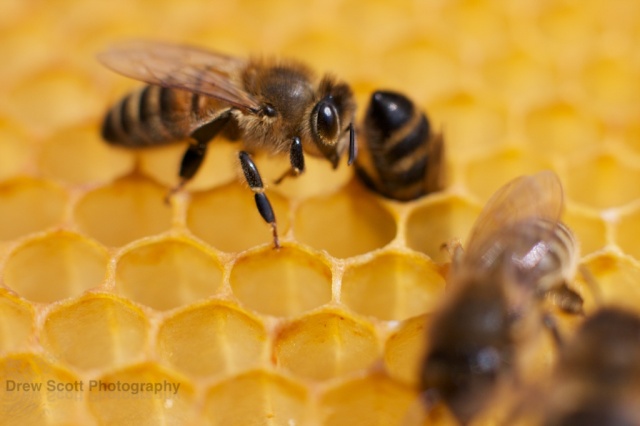It’s fun to investigate what people search for to find my blog. I’ve noticed a wiggling, shaking and bum-raising theme:
‘Why do bees wiggle their bums’
&
‘Why do bees shake their bum’
&
‘Why do bee butts pulse’
&
‘Why do bees put their bums in the air’
Well, here’s some potential answers…
1. Why do bees shake their bum?
One reason is to dance! The well-known waggle dance tells honey bees where food sources over 100m away are located. It’s a figure of eight shape with the bum waggle in the middle. The dancer will stop to exchange the nectar she’s collected with ‘watching’ workers so that they know what they’re looking for (I say watching but they’re really feeling her vibrations, as the dances are done in the dark of the hive).
The direction of the dance on the vertical face of the comb indicates the direction of the flowers in relation to the sun. As honey bees can see polarized light, the sun does not have to be shining for the dance to be successful. The nearer and more high quality the forage, the faster the dance and the more waggles in the middle.
There are also other types of honey bee dances that involve abdomen waggles/vibrations:
- round (tells other foragers there is food somewhere within 15m of the hive)
- transition (halfway between a round and waggle dance, if food is between 15 and 100m away)
- buzzing runs (an excited dance. The worker runs through the colony buzzing her wings. Other workers she runs into will pick up her movement and start running around buzzing too. It’s used as a signal for a swarm to exit the hive or take off once a new home has been found.)
- DVAV (dorsoventral abdominal vibrating dance) (get a move on – a worker will mount or grab another bee and vibrate their abdomen on top of her. Used to recruit more foragers during a nectar flow.)
In my previous post on Bee communication I went into more detail about the various meanings of honey bee vibrations and movements.
2. What does it mean when a honey bee butt moves in and out or pulses?
This search suggests the observer was not seeing a communication dance but something else – breathing!
Bees have no lungs but move oxygen into their bodies through breathing tubes (tracheae), which are connected to surrounding air through multiple holes in their body called spiracles.
In his book ‘The Biology of the Honey Bee’ (1987), Mark L.Winston explains that “When the bee is inactive gas exchange can operate simply by diffusion, but during periods of increased activity bees pump their abdomens to increase gas exchange” (p.34).
This pumping movement makes the abdomen move rhythmically as oxygen goes in – which could be the ‘in and out’ movement the searcher was thinking of. A bit like us breathing more heavily and panting after we’ve been running fast.
3. Why do bees put their bums in the air?
Honey bee workers will raise their abdomens in the air to expose a gland called their Nasonov gland. An scent attractive to other bees is released by this gland. The bees will fan their wings while raising their bottoms, to disperse and spread the Nasonov scent.
Nasonov is used by the bees to mark previously scentless locations such as water or a new colony location. I have seen my bees do it when their hive was moved a couple of feet, presumably to help returning foragers find their way home. Similarly, when a virgin queen leaves the hive to mate, workers will mark the entrance with Nasonov pheromone to guide her back.




Interesting.
Humans also expel gas by working their abdominal areas . . . although the results are seldom pleasant.
LikeLiked by 1 person
Ha! And the movement perhaps not so obvious, except in extreme cases.
LikeLiked by 1 person
Ian Stell has an article in the BBKA news called ‘Do bees pant?’
It is republished in the reprint of the articles http://www.bbka.org.uk/shop/product/bbka-news-honey-bee-anatomy/
LikeLike
Thanks Di. I managed to find the November 2011 issue on the circulatory system on the BBKA website at http://www.bbka.org.uk/files/library/november-2011-bbka-news_1340712542.pdf, though it doesn’t have title ‘Do bees pant?’. It does talk about the vibrating dorsal diaphragm (p.9).
LikeLike
So good to hear that someone is still able to find giggles among their remaining visible search terms. It gives us hope. And thank you for sharing them.
We actually spent a few moments wondering what the ‘pepperpot’ might have been. Drone genitalia partially protruding from a queen’s bottom? Never struck us as looking much like a pepperpot. Then we realized that bees were never mentioned in that particular search and an entirely different scenario was pictured.
An invasion of miniature Daleks.
LikeLike
I like your imagination! Protruding genitalia and miniature Daleks! Let’s hope so. I think my writing about ‘pepperpot’ effect brood (where some hatches and some doesn’t) confused the search engine.
LikeLike
Yes. We had to try searching your site with that term ourselves and found https://adventuresinbeeland.com/2012/12/01/4th-honey-bee-pests-diseases-and-poisoning-revision-post-viral-diseases-patchy-brood-bald-brood-stone-brood-and-nosema/ in which we learned of diploid drones. Fascinating.
LikeLiked by 1 person
Weird searches: “pepper pot in rectum” certainly trumps my oddest, “how to dispose of dead body?”. Maybe they thought a wildlife site might help. But with your query I can’t think where bees would fit in. As it were. RH
LikeLike
Hmm I think your oddest search is a wee bit more disturbing though! There is such a thing as a pepperpot brood pattern so perhaps that confused the search engine.
LikeLike
I’ve noticed the in and out movement of the abdomen while they are taking nectar. It looked a bit as if they were sucking it (severe case of anthropocentric thinking) but following your explanation, they are working hard and need more oxygen for respiration. Amelia
LikeLike
Yes I think so. A bit like our chests heaving after a run.
LikeLiked by 1 person
Cool info. Thank you.
LikeLike
You’re welcome 🙂
LikeLike
An enjoyable post, thanks Emily. It can be a frustrating business try to phrase a query so a poor old search engine can find an answer, you can almost hear the desperation in some – probably their 20th attempt or so! There’s a lot to be said for reading books!
LikeLike
Yes indeed, I’m a total bee book addict 🙂
LikeLike
Pingback: Of bee butts and wiggles | How To Raise Bees
Pingback: Of bee butts and wiggles | Raising Honey Bees
I am totally fascinated with bees…I received on my Facebook page about a week ago (July 2018) about how special paper with UV and glucose is helping the bees to thrive and how bees are helping humans to thrive. But every time I look up something about bees, there is a link on another interesting fact about bees.
Unfortunately My Father was very very allergic to bees and his cousin died of a bee sting. Bee allergy in the genes…
Laurie Yair
LikeLike
Thanks Laurie – I saw something about the special paper too. You never run out of interesting facts to read about bees. What a shame that you have bee allergy in the genes. Perhaps you might have escaped, but I can understand why you wouldn’t want to test that!
LikeLike
Hi Emily
I am not allergic to bees..got stung when pregnant in fact. Bees have never bothered me but to be a beekeeper? I wouldn’t have the guts! So we hear that we need bees but we ALSO need BEEKEEPERS and we must be thankful to them too!!!
LikeLike
I’m not a particularly brave person – doesn’t take a lot of guts! Just a calm, steady hand.
LikeLike
Pingback: Catching a swarm: My First Swarm mistakes - Tripbeez.ca